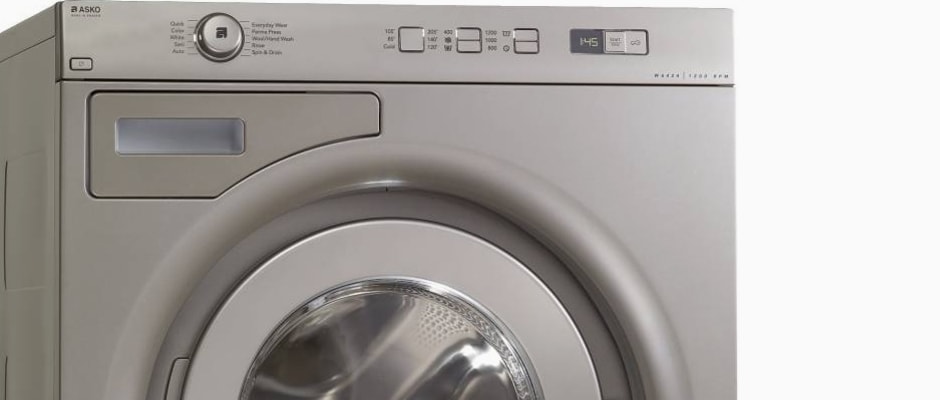Pros
Cons
Introduction
When we tested the Asko W6424T compact washer (MSRP $1,630) in 2012, the Swedish company was best known in the US for its high-end washers, dryers, and dishwashers. Today, Slovenian appliance manufacturer Gorenje is Asko's parent company. Although production has moved from Sweden to Slovenia, the design remains basically the same.
Retail prices hover north of $1,400 for the silver-toned W6424T, and slightly less for the W6424W. While that makes it one of Asko's least expensive units, it's hundreds of dollars more expensive than other compact, stackable European-style washing machines from Bosch, Electrolux, Ariston, and Blomberg.
Unlike many of its competitors, the W6424 is designed to be installed in a kitchen, and an extremely stylish machine—although its user interface suffers as a result. It cleans as well as its competitors, but its performance doesn’t offer any compelling reason for a consumer to pay so much. It’s not a bad washer, but it’s not a very good value, either.
Design & Usability
{{section_header}}{{section.name}}{{/section_header}}
The {{product.name}} emphasizes style over substance.
Outside of the US, it’s common to have a washing machine in the kitchen, which explains why the W6424 is so good looking. Tiny controls are about form, not function, and the electronically-operated door is a real pain. Unfortunately, the {{product.name}}'s small door means that it's pretty hard to load laundry, too.
As with all compact machines, fitting in a standard eight-pound load requires some maneuvering, which we found frustrating. Washing a larger load would be almost impossible. It’s also important to note that the W6424 runs on a 220V current and features a special plug that’s designed to fit into a compatible Asko dryer. Unless you’re an electrician, you’ll need a dryer and a 220V outlet nearby.
{{photo_gallery "Front Image", "Controls 1 Photo", "Controls 2 Photo", "Drawer Photo", "Lint Trap Photo", "Interior Photo", "Interior Detail Photo", "Sides Photo", "Sides Detail 1 Photo", "Side Detail 2 Photo", "Back Photo", "Back Detail Photo"}}
Performance & Features
{{section_header}}{{section.name}}{{/section_header}}
All cycles take a while to complete, and cleaning performance is only slightly above average.
The Asko proved to be moderately disappointing. While we don't expect compact washers to perform as well as their full-size counterparts—most of them take a long time to complete cycles—most of them sell for under $1,000. This $1,400+ machine didn't add any performance boost over machines that have the same footprint but a smaller pricetag.
Per the owner's manual, we used the "Auto" cycle for a normal clothes wash. It took over two hours to complete, though it got clothes extremely clean. If you don't have that kind of time, we'd recommend using the Perma Press or even Quick cycle for most normally soiled laundry loads. For more soiled loads, the Heavy/White cycle may be more productive. It may have taken nearly two and a half hours, but it was the best our Asko had to offer.
On the features front, we were especially impressed by the Asko W6424’s temperature options, which range from tap-cold water to a 205ºF sanitizing cycle. Unlike many other washers we’ve tested, the Asko’s promised temperatures matched what we observed.
Conclusion
{{section_header}}{{section.name}}{{/section_header}}
The Asko W6424 may be attractive enough to install in a kitchen, but its price didn't match its good looks.
Though one would expect a lot from a washer that sells for more than $1,400, this compact Asko didn't outclean its less attractive competitors.
In addition to its Scandinavian design, we were impressed by the W6424's energy efficiency, but again, the cost savings per wash could never make up for Asko's price premium.
About the only thing low-cost about this appliance is how much you'll pay per wash. Thanks to an internal water heater, the Asko only draws cold water, though it can bring it up to as warm as 205ºF. But unless you value appearances, there are many other washers on the market to choose from that will get your clothes just as clean, leaving your bank account unscathed.
Science Introduction
{{section_header}}{{section.name}}{{/section_header}}
The {{product.name}} had a slightly above average washing performance, yet it seems much less appealing when you consider its $1,299 MSRP. This is one of the few washers where we would recommend using the Quick Wash option. Quick is a relative term, as this cycle took 40 minutes to complete. It got clothes cleaner than many normal cycles on other full-size washers we’ve tested. Absent any major stains, we’d recommend Asko owners use the Quick Wash for most loads. Read on for more about our testing.
Performance Tests: Cleaning
{{section_header}}{{section.name}}{{/section_header}}
Can slow and steady really win the race?
In order to determine cleaning performance we use sets of stain strips with standardized patches. Each patch is stained with a common household dirtying agent. They include things like sebum (sweat), blood, oil, red wine, and cocoa. These strips are placed in eight pound loads of laundry with a pre-measured amount of industry approved detergent. When the cycle is complete, we scan the strips with a light spectrometer. These readings are compared to control samples to determine how much of the stain has been removed.
The best stain removal performance came while running the Heavy/White cycle. All stains across the board were greatly diminished. Across the board, the Asko did a great job at stain removal when compared to other compact machines.
{{photo_gallery "Science Section 1 Images"}}
Performance Tests: Efficiency
{{section_header}}{{section.name}}{{/section_header}}
If you can stomach the initial purchase price, you'll be pleased to see your energy and water bills decrease.
The Asko W6424 uses only cold water, heating it internally. That will slightly drive up the cost of electricity this washer uses, but it'll save your hot water heater from doing the same work. Outside of the US, many homes use tankless water heaters. As such, this Asko heats its own water and only draws from a cold tap. That means serious hot water savings. Even cold water usage is moderate.
{{photo_gallery "Science Section 2 Images"}}
Meet the tester
Keith was the Editor in Chief of Reviewed's appliance and automotive sites. His work has appeared in publications such as Wired, Car & Driver, and CityLab.
Checking our work.
Our team is here to help you buy the best stuff and love what you own. Our writers, editors, and experts obsess over the products we cover to make sure you're confident and satisfied. Have a different opinion about something we recommend? Email us and we'll compare notes.
Shoot us an email

